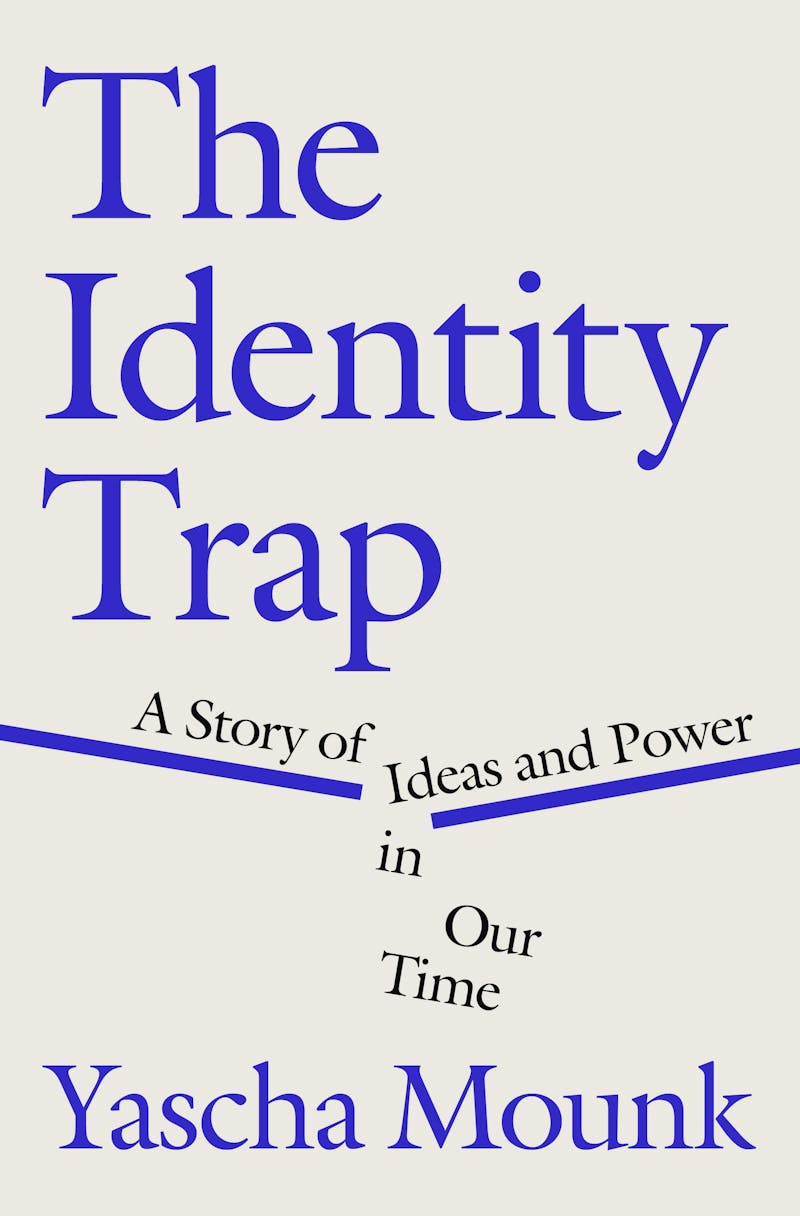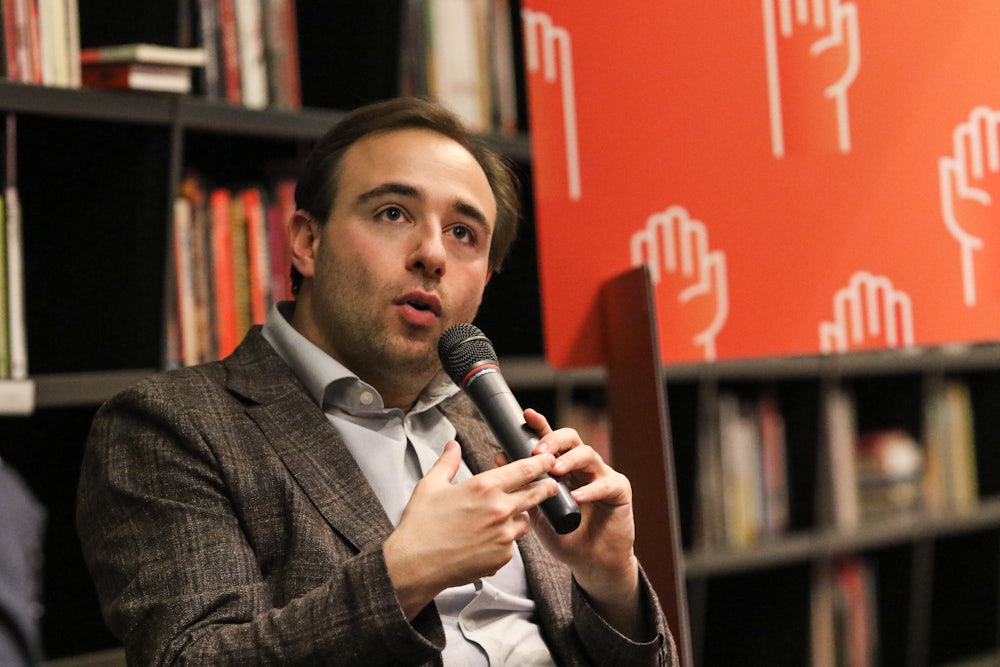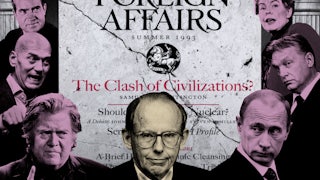The world according to Yascha Mounk is a bleak place: In the stranglehold of a new ideology, contemporary society has abandoned the liberal tenets that once guided it, in favor of race-based segregation and discrimination. This ideology is not, as you might be thinking, that of Donald Trump or Ron DeSantis. It is not the fascism of the new right. No, it is an ideology of the left. What some call “wokeism,” “identity politics,” or “cultural Marxism,” Mounk terms the “identity synthesis.”
In The Identity Trap: A Story of Ideas and Power in Our Time, Mounk spins a tale of how once obscure academic thought came to shape society. Starting with French philosopher Michel Foucault and working his way through postmodern thinkers including Edward Said, Gayatri Spivak, Derrick Bell, and Kimberlé Crenshaw, he contends that their complex scholarly ideas evolved over the last 50 years into the “identity synthesis.” This synthesis, according to Mounk, is an “ideology” that encompasses a “rejection of grand narratives,” the “embrace of the need for intellectuals to speak on behalf of oppressed groups,” and a rejection of “racial integration,” along with other “key values of the civil rights movement.” Out of a desire to help oppressed groups, that is, grew an ideology that ultimately reifies identity and rejects the possibility of cross-group solidarity.

Mounk begins his story with capsule histories of these scholars, arguing that their ideas escaped the ivory tower. Spreading from out-of-the-way conference panels and niche academic departments, they first became dominant within academia at large and then in other elite institutions.
They have spread through two mechanisms, Mounk argues. First, he identifies the internet, specifically social media sites such as Tumblr, as a vector for the spread of bowdlerized versions of these strands of academic thought. Second, he contends that progressive graduates of elite universities made a “short march through the institutions” (a spoof on West German 68er Rudi Dutschke’s call for a “long march through the institutions”). Instead of hanging around the academy, those graduates, Mounk tells us, are now employees (or even leaders) at powerful corporations, nonprofits, and governments, where they spread their teachers’ gospel.
A simplified version of the “identity synthesis” has thus, in Mounk’s view, become dominant across the country, leading elite institutions and governments to discriminate on the basis of gender and race in the name of lifting up historically marginalized groups. He points to a handful of examples, such as a Centers for Disease Control and Prevention panel’s preliminary recommendation in 2020 that Covid vaccines should be made available to essential workers before the elderly, as evidence of the “tremendous influence” that the “identity synthesis” enjoys as it has “reshaped some of the most powerful institutions in the country.”
It’s a straightforward story. But it only hangs together if you don’t press too hard. In particular, Mounk’s argument suffers from two major flaws.
First, ideas seem to take on a life of their own in his account. Mounk has more or less gotten the academic theory right. Michel Foucault’s critique of power did reject “grand narratives,” including much of the liberal tradition. What Gayatri Spivak termed “strategic essentialism” has been an important tactic for minoritized groups struggling for liberation (although there’s nothing new here: As Jason Blakely recently pointed out in a critique of The Identity Trap, what’s often termed “identity politics” goes back to at least the first European nationalists of the eighteenth and nineteenth centuries). Scholars like Kimberlé Crenshaw have critiqued the way that liberal jurisprudence limits the scope of liberation.
But trouble starts when Mounk argues that “a new generation of scholars succeeded in welding a diverse set of influences into one coherent ideology.” This ideology, he writes, consists of “seven fundamental propositions,” namely skepticism toward objective truth, politicized discourse analysis, the “embrace of essentialist categories of identity,” pessimism about the West, a preference for policies that “make how someone is treated depend on the group to which they belong,” “intersectional logic for political activism,” and “skepticism about the ability of members of different identity groups to understand each other.” Now, in my experience, it’s difficult to get a group of academics to agree on any one proposition, let alone seven. But that is not the biggest problem with the book.
How, when, and even whether these ideas escaped their academic homes is the real quandary. Most of Mounk’s thinkers penned their famous essays and monographs decades ago. Foucault published Discipline and Punish in 1975, and Crenshaw coined the term “intersectionality” in 1989. Why did their ideas only make it into the mainstream—according to Mounk—many years later? What spurred college graduates to make their “short march” in the 2010s as opposed, to, say, the 1990s?
Part of Mounk’s answer lies in technology: the rise of social media and the unprecedented democratization of knowledge it represents (for good or ill). The other answer Mounk gives is the 2016 presidential election. Donald Trump’s nativist campaign spurred a new generation of activists to take lingering racism (and misogyny) more seriously. “The widespread horror at the election of Donald Trump,” he insists, “accelerated the takeover of the identity synthesis in many elite institutions.” Worse, he writes, leftists started to turn on each other, seeking to make a difference within progressive institutions as they were barred from the halls of power in Washington, D.C.
That story is, in my view, not incorrect so much as incomplete. Most of Mounk’s examples of the “identity synthesis” cluster around the year 2020. And while Trump’s presidency—and the horror it inspired among many progressive Americans—was undoubtedly a catalyst for the rising popularity of certain ideas, such as “diversity, equity, and inclusion” or “intersectionality,” that Mounk identifies as elements of the “identity synthesis,” he largely skates by the effects of that year’s two major events. The first, of course, is the Covid-19 pandemic, which forced much of the nation indoors and into isolation. As concern about the disease has receded and life has returned to “normal,” it seems (anecdotally) like public passion for DEI and other hallmarks of the “identity synthesis” has also retreated.
But, even more surprising, Mounk barely mentions what I would argue is the true catalyst for the spread of some of these ideas, namely the police murder of George Floyd on May 25, 2020. His killing spurred some of the largest protests in American history and made racial equity impossible for governments and corporations to ignore. Under pressure from progressives shocked by the brutality of Floyd’s death, city councils around the country explored efforts to shrink or “defund” police departments. Corporate America promised to do more to hire, retain, and promote BIPOC employees. I was surprised that, in a book largely concerned with contemporary racial politics in the United States, Floyd’s death is mentioned only once. After all, the summer of 2020 did mark a real break in the country’s racial politics and a breakthrough of many of the concepts that Mounk critiques.
I do not know why Mounk ignores this catalyzing moment. But if he had talked about police violence against Black Americans, it might have resulted in a far more reasonable picture of why certain ideas could have garnered a second look in 2020 from progressives desperate to stop such brutality.
The larger problem for Mounk’s narrative is that many of the ideas that swept onto the scene in 2020 have ebbed just as quickly in the months and years since. Calls for reforming or “defunding” the police have for instance mostly lost traction. By last year, most municipalities were back to business as usual, granting local police departments large budget increases. Diversity, equity, and inclusion, or DEI, efforts have been rolled back around the country, often as a result of government intervention (not to mention the Supreme Court’s 2023 decisions striking down affirmative action).
This leads me to the second major flaw in Mounk’s argument: It is my opinion that he is, ultimately, arguing against a straw man. Now, every good straw man has a kernel of truth to it. The thinkers he cites are major influences on humanists writing today, and some of their ideas have made their way into the mainstream. I also do not deny that, if you go looking for them, you can and will find examples of people (sometimes people in positions of power) behaving in frankly idiotic ways while claiming to be inspired by these ideas. But such examples are few and far between and, as I have noted, tend to cluster around the year 2020.
When Mounk does hit on a good example, he tends to recycle it. He begins the book with the case of Sharyn Briscoe, a Black principal in Georgia who was accused in 2021 of sorting students into Black and white classrooms. Briscoe had done so, apparently, under the belief that it was better for children who “look like” each other to be placed together. This case, which resulted in an ongoing federal investigation by the Department of Education’s Office for Civil Rights, pops up two more times in the book.
The case of Emmanuel Cafferty crops up twice. An electrician from southern California, Cafferty was photographed in June 2020 with his hand making a gesture that people on Twitter misinterpreted as a white power symbol. As a result, he lost his job and is suing for wrongful termination.
Then there is the example of that CDC panel from 2020, which also comes up twice and forms the crux of one of Mounk’s chapters. The Advisory Committee on Immunization Practices issued nonbinding guidelines in early December 2020, which recommended that essential workers receive scarce Covid-19 vaccinations before older Americans. It justified the decision as a way to introduce racial equity to vaccine distribution, noting that essential workers are less likely to be white than older Americans. After a public outcry, the panel changed course, recommending a few weeks later that older Americans get access before most essential workers.
One of the book’s principal conceits is that these case studies are part of a larger trend. At one point, Mounk asserts that “many schools have introduced race-segregated affinity groups.” Elsewhere, he insists there is an “extraordinary upswell of attempts to fire or ostracize people for alleged violations of community norms.” He also suggests that “a large number of people have been summarily fired from their jobs for offenses either trivial or imaginary.” Although the book is unusually well sourced for a trade publication, none of these statements has a citation that backs up the claim that these cases are anything other than isolated incidents. There are no hard data to ground what amounts to anecdotal observation.
The fact of the matter is, there are no statistics showing a meaningful rise in this kind of behavior (at least none that I’ve seen), which is why Mounk has to rely on a handful of isolated incidents. It’s also worth reiterating that in many of his examples, the proposal or action that Mounk cites as evidence of the “identity synthesis” was quickly rejected or overturned, suggesting that these ideas are far less influential than Mounk would have his readers believe.
If there were, in fact, an “extraordinary upswell of attempts to fire” people who did not conform to the “identity synthesis,” you might expect to see a commensurate increase in wrongful termination suits. But this is not the case. And in the handful of cases in which individuals have filed such suits alleging that workplace diversity trainings discriminated against them as white people, courts have largely sided with their employers. There’s simply no there there.
In fact, one of the few areas in which we do have reliable statistics paints a strikingly different picture. Cases of “cancellation” on university campuses have indeed been on the rise in recent years: scholars bullied, censored, or even fired for their scholarly or political views. The problem for writers like Mounk, though, is that many of these cases are of left-wing scholars being harassed by right-wing students, politicians, or organizations. Jeffrey Sachs, a scholar who tracks faculty terminations, found that between 2015 and 2016, vastly more faculty were disciplined for left-wing speech than for right-wing speech.
Data from FIRE, the Foundation for Individual Rights and Expression, which also maintains a database of campus free speech cases, indicates that the number of right- and left-wing incidents are roughly equal so far in 2023. And although some have raised questions about FIRE’s methodology, suggesting that it undercounts cases of harassment inspired by the right, the organization notes that the largest surge in sanction attempts was driven by conservative group “Turning Point USA calling on parents and students to contact the institutions of 61 professors featured on their Professor Watchlist website.”
Yes, there are certainly cases of left-wing students and faculty petitioning for right-wing scholars to be disciplined, disinvited, or even fired. But the data hardly show a dominant “woke” or identitarian ideology taking over college campuses. Compared to right-wing efforts in state government to ban books and rewrite university and K-12 curricula, these cases seem downright insignificant.
While Mounk has identified some very real strands of academic thought, he thus exaggerates their coherence as well as their influence on contemporary politics and society. The “identity synthesis”—to the extent that we can even describe it as an intelligible ideology—was never dominant in this country and, at most, enjoyed a blip of widespread interest around 2020 before again receding.
A better question might be why so many writers have decided to focus on such a seemingly insignificant phenomenon. Over the last decade, a group of writers often termed “reactionary centrists” have turned complaining about “wokeness,” “cancel culture,” “identity politics,” and the like into a small industry. I don’t claim to know the personal motivation of these writers and pundits, but in the years since they have forced these buzzwords into common parlance, far-right politicians have seized on them to enact reactionary policies. Decrying the “woke liberal agenda,” a candidate for governor in Missouri recently talked about burning books (and used a flamethrower on a pile of cardboard boxes to underscore his point). Ron DeSantis’s signature Stop WOKE Act was passed in 2022, gagging teachers and scholars and censoring discussion of race and gender. In the name of stopping wokeness, 14 states have promulgated laws that restrict discussion of LGBTQ issues in K-12 education. In the case of “wokeness” (or the “identity synthesis”) the cure is much, much worse than the disease.
To Mounk’s credit, he does engage with some of these arguments. He points out that he has already written two books about the far right. He also urges his readers not to let annoyance with the “identity synthesis” turn them into a “reactionary.” Nonetheless, I worry that that is precisely what a book like this may do. By exaggerating the threat posed by these progressive ideas, which only ever briefly enjoyed any real reception or influence, he makes it easier for his readers to ignore the much more real threat menacing from the right.
For if we are worried about free speech, equal opportunity, and human dignity, we should be far more concerned about Republicans who have spent the last years banning books, restricting health care, and censoring education. That is the path to illiberalism; there lies the road to fascism.






